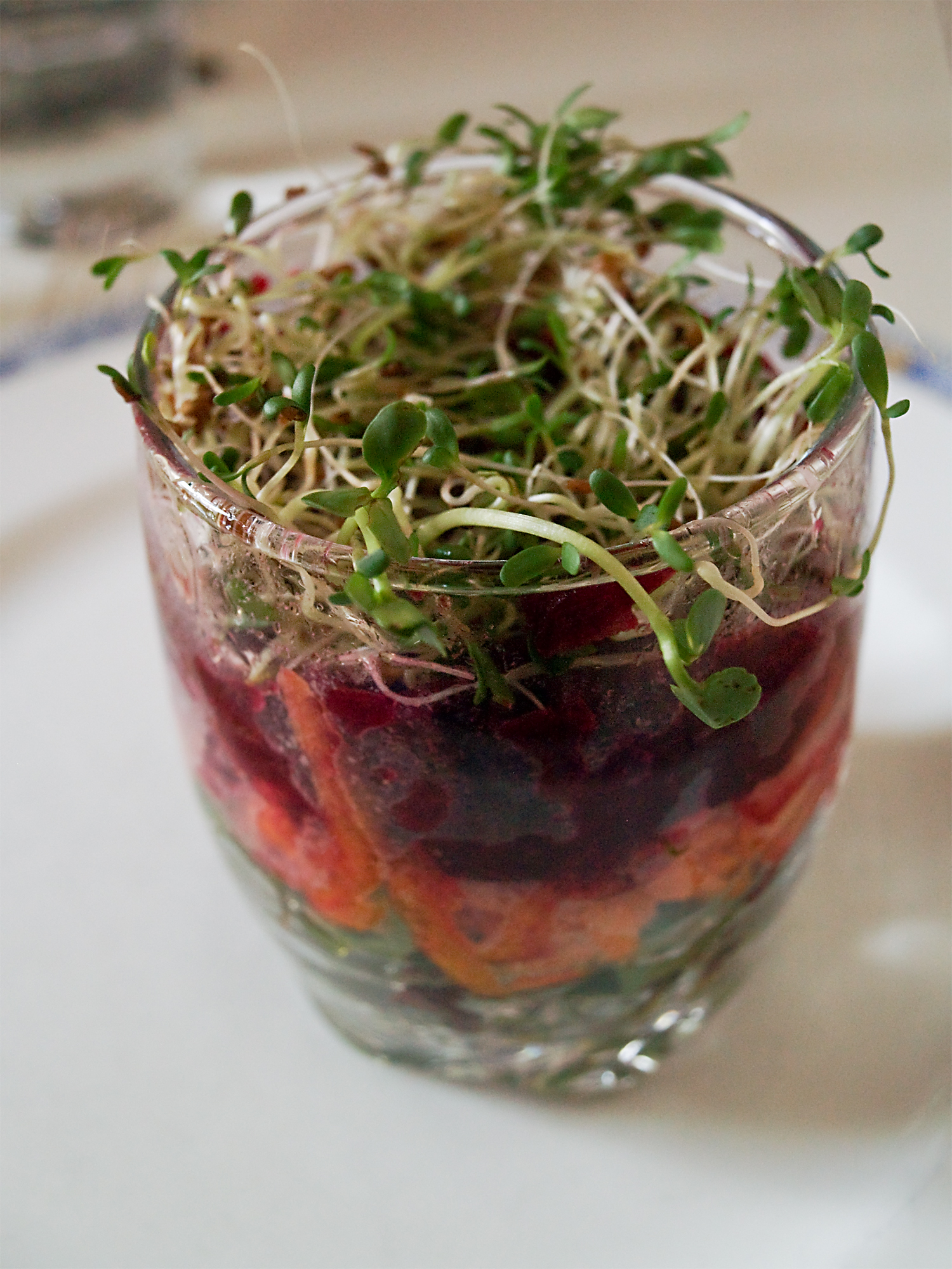Verrine on:
[Wikipedia]
[Google]
[Amazon]
 A verrine () is a glass container, often small, in which is served a starter, main course or dessert, rather than a drink. The glass might be able to be used for drinks, but when used for food, it is referred to as a verrine, and indeed the dish itself can be named ″a verrine″.''Larousse Gastronomique'', p. 887 left column, article "verrine" (French) This French word is usually left untranslated because there is no single English word for it. wiktionary:verrine
Metonymously, a "verrine" designates in the cooking world a dish served in a verrine, in a vertical manner, allowing a different aesthetic and gustatory experience compared to a dish served on a plate.
Philippe Conticini was the first (in 1994) to imagine a dessert served in a verrine. He introduced more than a simple evolution of the form, but rather a notable evolution in taste experience.
The verticality and transparency of the verrine allows:
* Immediate visual reading and construction of
A verrine () is a glass container, often small, in which is served a starter, main course or dessert, rather than a drink. The glass might be able to be used for drinks, but when used for food, it is referred to as a verrine, and indeed the dish itself can be named ″a verrine″.''Larousse Gastronomique'', p. 887 left column, article "verrine" (French) This French word is usually left untranslated because there is no single English word for it. wiktionary:verrine
Metonymously, a "verrine" designates in the cooking world a dish served in a verrine, in a vertical manner, allowing a different aesthetic and gustatory experience compared to a dish served on a plate.
Philippe Conticini was the first (in 1994) to imagine a dessert served in a verrine. He introduced more than a simple evolution of the form, but rather a notable evolution in taste experience.
The verticality and transparency of the verrine allows:
* Immediate visual reading and construction of
 A verrine () is a glass container, often small, in which is served a starter, main course or dessert, rather than a drink. The glass might be able to be used for drinks, but when used for food, it is referred to as a verrine, and indeed the dish itself can be named ″a verrine″.''Larousse Gastronomique'', p. 887 left column, article "verrine" (French) This French word is usually left untranslated because there is no single English word for it. wiktionary:verrine
Metonymously, a "verrine" designates in the cooking world a dish served in a verrine, in a vertical manner, allowing a different aesthetic and gustatory experience compared to a dish served on a plate.
Philippe Conticini was the first (in 1994) to imagine a dessert served in a verrine. He introduced more than a simple evolution of the form, but rather a notable evolution in taste experience.
The verticality and transparency of the verrine allows:
* Immediate visual reading and construction of
A verrine () is a glass container, often small, in which is served a starter, main course or dessert, rather than a drink. The glass might be able to be used for drinks, but when used for food, it is referred to as a verrine, and indeed the dish itself can be named ″a verrine″.''Larousse Gastronomique'', p. 887 left column, article "verrine" (French) This French word is usually left untranslated because there is no single English word for it. wiktionary:verrine
Metonymously, a "verrine" designates in the cooking world a dish served in a verrine, in a vertical manner, allowing a different aesthetic and gustatory experience compared to a dish served on a plate.
Philippe Conticini was the first (in 1994) to imagine a dessert served in a verrine. He introduced more than a simple evolution of the form, but rather a notable evolution in taste experience.
The verticality and transparency of the verrine allows:
* Immediate visual reading and construction of taste
The gustatory system or sense of taste is the sensory system that is partially responsible for the perception of taste (flavor). Taste is the perception produced or stimulated when a substance in the mouth reacts chemically with taste receptor ...
, and
* Completion of the gustatory balance in the mouth rather than in the verrine; sensations of intensity and finish are strengthened and better controlled by the experiencer.
According to the original concept, verrines are composed of three layers, each conveying specific taste characteristics:
* The upper, thin layer is made of an acidic preparation to trigger salivation and prepare the taste buds to receive other tastes
* The intermediate, thicker layer consists of a preparation bringing the "main flavor"
* The lower layer consists of a smooth and silky preparation aimed at coating the taste buds and providing a full-bodied, pleasant finish.
References
{{Portal, food Serving and dining